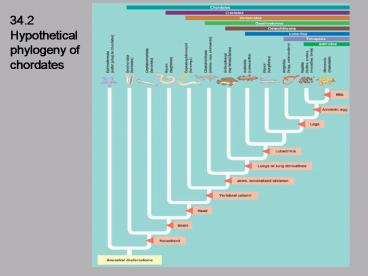34'2 Hypothetical phylogeny of chordates - PowerPoint PPT Presentation
1 / 37
Title: 34'2 Hypothetical phylogeny of chordates
1
34.2 Hypothetical phylogeny of chordates
2
34.20. The origin of Tetrapods
3
34.21 Amphibian orders Salamanders (top), frogs
(middle), and caecilians (bottom).
Costa Rica 2005 Field course
4
(No Transcript)
5
34.22 Dual life of a frog (Rana temporaria)
6
(No Transcript)
7
http//amphibiaweb.org/declines/declines.html
8
34.2 Hypothetical phylogeny of chordates
9
34.24 Amniotic egg
10
Taxonomic classes of amniotes
11
34.23. Phylogeny of amniotes. Extant groups
identified in red.
12
A Tuatara
Sea turtle
13
34.25 A hatching reptile (Komodo dragon)
14
34.27 Extant reptiles (other than birds) Desert
tortoise (top left), lizard (top right), king
snake (bottom left), alligators (bottom right)
15
Banded gecko, Coleonyx varigatus
16
Emerald tree boa
17
34.23. Phylogeny of amniotes. Extant groups
identified in red.
18
34.30 A small sample of birds Blue-footed
boobies (top left), male peacock (top right),
penguins (bottom left), perching bird (bottom
right)
19
Archaeopteryx
20
34.29 Artist reconstruction of Archaeopteryx, a
Jurassic bird-reptile.(note many remaining
traits of non-bird reptiles)
21
34.28 Form fits function the avian wing and
feather
22
34.26 A bald eagle in flight
23
Rhea Pantanal, Brazil
24
(No Transcript)
25
34.2 Hypothetical phylogeny of chordates
26
34.36 Hypothetical cladogram of mammals
27
Australian monotremes and marsupials echidna
(top left), platypus (top right), marsupial mouse
(lower left), sugar glider (lower right)
28
34.34. Australian marsupials
The opossum the only marsupial in North America.
29
Figure 34.35 Evolutionary convergence of
marsupial and eutherian (placental) mammals
Convergent evolution Organisms, not closely
related, independently evolve similar traits as
they both adapt to similar environments
30
Placental mamals
31
34.38A phylogenetic tree of primates
32
Prosimians Lemurs
33
A capuchin, a New World monkey (left), and a
vervet, an Old World monkey (right)
34
(No Transcript)
35
Apes Gibbon (top left), orangutan (top right),
gorilla (bottom left), chimpanzee (bottom right)
36
34.41 A timeline for some hominid species
37
(No Transcript)































